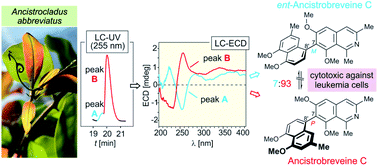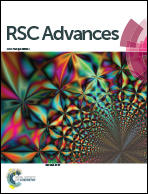Ancistrobreveines A–D and related dehydrogenated naphthylisoquinoline alkaloids with antiproliferative activities against leukemia cells, from the West African liana Ancistrocladus abbreviatus†
Abstract
A unique series of six biaryl natural products displaying four different coupling types (5,1′, 7,1′, 7,8′, and 5,8′) were isolated from the roots of the West African liana Ancistrocladus abbreviatus (Ancistrocladaceae). Although at first sight structurally diverse, these secondary metabolites all have in common that they belong to the rare group of naphthylisoquinoline alkaloids with a fully dehydrogenated isoquinoline portion. Among the African Ancistrocladus species, A. abbreviatus is so far only the second one that was found to produce compounds with such a molecular entity. Here, we report on four new representatives, named ancistrobreveines A–D (12–14, and 6). They were identified along with the two known alkaloids 6-O-methylhamateine (4) and ent-dioncophylleine A (10). The two latter naphthylisoquinolines had so far only been detected in Ancistrocladus species from Southeast Asia. All of these fully dehydrogenated alkaloids have in common being optically active despite the absence of stereogenic centers, due to the presence of the rotationally hindered biaryl axis as the only element of chirality. Except for ent-dioncophylleine A (10), which lacks an oxygen function at C-6, the ancistrobreveines A–D (12–14, and 6) and 6-O-methylhamateine (4) are 6-oxygenated alkaloids, and are, thus, typical ‘Ancistrocladaceae-type’ compounds. Ancistrobreveine C (14), is the first – and so far only – example of a 7,8′-linked fully dehydrogenated naphthylisoquinoline discovered in nature that is configurationally stable at the biaryl axis. The stereostructures of the new alkaloids were established by spectroscopic (in particular HRESIMS, 1D and 2D NMR) and chiroptical (electronic circular dichroism) methods. Ancistrobreveine C (14) and 6-O-methylhamateine (4) exhibited strong antiproliferative activities against drug-sensitive acute lymphoblastic CCRF-CEM leukemia cells and their multidrug-resistant subline, CEM/ADR5000.



 Please wait while we load your content...
Please wait while we load your content...